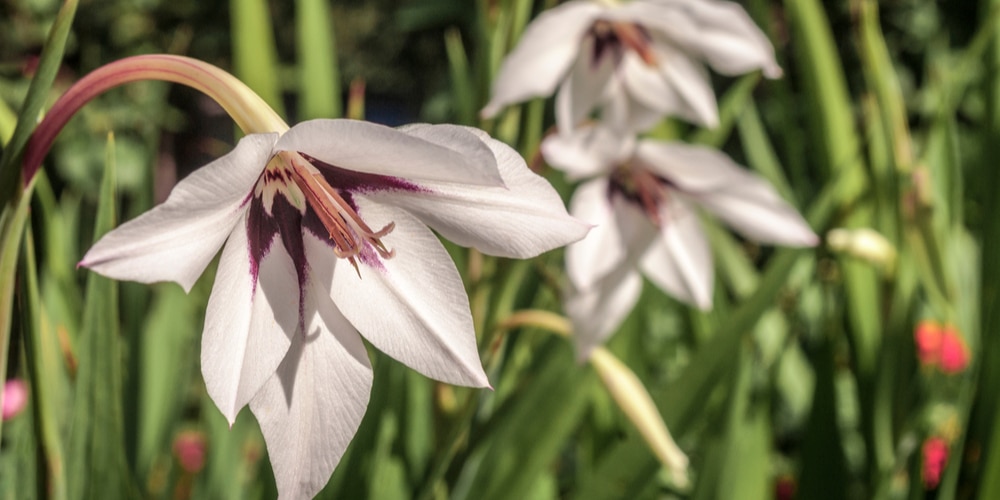Abyssinian Gladiolus is a delicate-looking plant with elegant blooms that produce a pleasant scent. It is the perfect addition to any space, especially if you want to add some movement and color.
Consider planting your gladiolus in groups for an even more dramatic effect. But what more should you know about this plant? Keep reading to learn everything you must know before planting your Abyssinian gladiolus bulbs in the spring!

| Botanical Name | Gladiolus callianthus |
| Common Name | Abyssinian Gladiolus |
| Plant Type | Perennial |
| Flower Color | White, star-shaped with an eye-catching purple center. |
| Size When Mature | Up to 3 ft tall |
| Bloom Time | Late Summer to Early Fall |
| Sun Requirements | Full Sun |
| USDA Hardiness Zones | 8-10 |
| Soil PH Range | 5.0-7.0 |
| Soil Type | Well-draining and fertile |
| Water Needs | Medium |
| Native Area | East Africa |
What you Need to Know About Abyssinian Gladiolus
Abyssinian Gladiolus is an elegant plant bearing spikes of star-shaped white and purple flowers that will be the delight of your garden. You can purchase bulbs at your favorite nursery. Plant them in early spring (after the last frost) to enjoy their flowers in the summer.
Be careful if you own a cat or a dog: this plant is toxic to these animals. However, it doesn’t seem to cause any damage to humans.
How to Care for Abyssinian Gladiolus
Abyssinian gladiolus isn’t a challenging plant to grow. However, it requires some attention from your side to thrive. You can find everything you need to know about it in the following sections.
Light
Place your Abyssinian Gladiolus in a sunny location: it will give you the best flowering. Indeed, these flowers might tolerate partial shade, but they won’t thrive under inadequate lighting.
Water and Soil Needs
This gorgeous plant isn’t too fussy about soil conditions. It will adapt to various substrates (except clay). However, it will perform much better in fertile soil. Consider adding organic material to increase the nutrient content. You can apply compost or manure. Also, think about adding mulch around your plants: increasing drainage, and improving water retention.
Temperature Requirements
However, this plant thrives in USDA 8 to 10. But you can still try growing it in colder regions, provided that you meet the plant’s growing requirements.
If you planted your gladiolus in a container, consider overwintering it indoors. Also, ensure you protect your plants from strong winds, as they might get damaged.
Fertilizer
Your Abyssinian gladiolus might grow better with the addition of fertilizer in the soil. If you don’t want to purchase one, consider mixing bone meal to increase the phosphorous content and support root growth. Use high-quality products to get better results. Also, don’t forget to follow the instructions you find on the label to prevent any issues.
Common Diseases
This plant might be susceptible to attacks from aphids, slugs, or thrips. Of course, its reaction to the infestation will depend on the plant’s health. We recommend you take action to eliminate the pests as soon as you notice something off with your plant.
In terms of diseases, you should pay attention to overwatering, which might cause the appearance of root rot, scab, or other leaf spots.
Abyssinian Gladiolus Propagation
You can propagate your Abyssinian Gladiolus by separating the corms during the dormancy period (usually in the fall and winter).
While seed germination also works, you’ll have better results propagating your plants by division. Don’t forget to plant your cormlets in suitable potting soil and choose a sunny location to grow them.
Related Article: Abyssinian Banana Care
